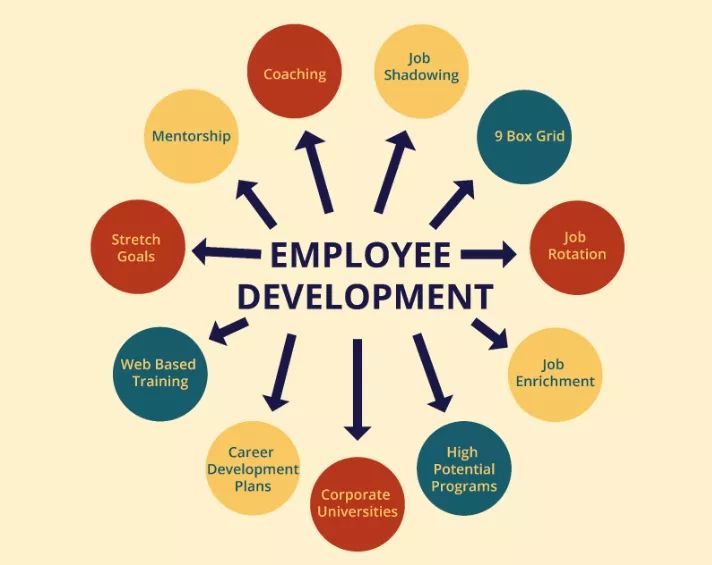
Investing in growth: Pluxee (Sodexo) and professional development opportunities
1 May 2025
In today's workplace, employees seek fulfilling career paths, and organisations are taking proactive steps to redefine their approach to talent retention. Employers are recognising the significance of offering benefits that can facilitate long-term commitment. Employees are eager to pursue new training opportunities, with 86% expressing readiness for professional development.
Millennials prioritise continuous learning and consider growth prospects as a crucial aspect while making career decisions. By understanding and aligning with these preferences, your organisation can position itself as an employer of choice. Join us as we explore the benefits of implementing workplace learning programmes.
Key takeaways
- Prioritising professional development aligns with employees' desires for long-term commitment, facilitating a strategic approach to talent retention.
- Understanding and actively catering to millennials' preference for continuous learning positions an organisation as a forward-thinking employer in today's marketplace.
- Cultivating a culture that values appreciation, recognition, and growth opportunities, coupled with well-structured learning programmes, is instrumental in achieving high employee retention and minimising hiring costs.
- Adapting to workplace trends, including remote work and technological advancements, underscores the imperative of organisational agility for long-term success.
- Employee satisfaction is intricately linked to learning and development opportunities, becoming a powerful retention tool and reducing the need for expensive hiring processes.
Adapting to the future: navigating trends in the modern workplace
In the modern workplace, several significant trends are reshaping how organisations operate. The proliferation of remote work, fueled by advancements in digital technology and artificial intelligence, has become a defining characteristic of the contemporary work environment. Numerous reports and research papers highlight the transformative impact of these trends. Organisations, to remain competitive, are recognising the imperative of agility. The ability to swiftly adapt to technological changes, market dynamics, and consumer behaviour is crucial for long-term success.
Moreover, continuous employee skill development becomes paramount as the workplace undergoes digital transformations. Research consistently underscores the correlation between a skilled workforce and organisational agility, providing compelling insights into the evolving nature of work.
Read more: The varied dimensions of quality of life
The significance of employee training
The workforce is the most valuable asset in any organisation, embodying the potential for innovation and adaptability. The saying, "An organisation's greatest asset is its people," underscores the profound impact of human capital. This mantra guides a strategic approach to employee development, recognising that a skilled and motivated workforce is pivotal for sustainable growth. Investing in comprehensive employee training becomes not only a choice but a necessity, aligning organisational success with the collective potential of its people. Training transforms individuals, fosters continuous improvement, and fortifies organisational adaptability in a vibrant business environment.

|
Did you know? As per a report, 71% of professionals express a willingness to change jobs if presented with the enticing prospect of flexible scheduling in a new role. This underscores the pivotal role of work-life balance in career decisions, reflecting a growing emphasis on employee well-being. |
Compelling reasons to invest in professional development for employees
Fostering continuous learning
Encourage a culture of continual learning within your workplace. This involves promoting attendance at training sessions, reading professional literature, participating in webinars, and other avenues for skill enhancement. Research indicates that organisations with effective learning environments exhibit greater organisational effectiveness. This maximises your training investment and creates a knowledge-sharing culture where employees become trainers, compounding the impact.
Boosting employee satisfaction and retention
Employees inherently desire learning and development opportunities, correlating with increased job satisfaction. Extensive training enhances their confidence and job effectiveness, resulting in higher happiness levels. Job satisfaction becomes a powerful retention tool, reducing the need for expensive hiring, onboarding, and training processes. Implement cost-effective training methods like mentorship programmes, coaching, job shadowing, and cross-training to cultivate a skilled and content workforce.
Building a stellar reputation
A robust learning and development programme promotes individual growth and solidifies your company's reputation as an employer that values and invests in its workforce. This positive image extends beyond internal stakeholders, resonating with customers who directly benefit from the expertise and professionalism of a well-trained workforce. In cultivating a stellar reputation, your commitment to employee development becomes a powerful asset that attracts and retains top talent and satisfied customers.
Explore more: How employee motivation drives success
Increasing customer loyalty
An impactful 94% of employees express willingness to extend their tenure with companies prioritising learning and development. This statistic underscores the direct link between employee growth initiatives and enhanced loyalty. Happy and skilled employees, through continuous development, deliver exceptional customer experiences, positively impacting customer satisfaction and loyalty.
Increasing retention
Workers value appreciation, recognition, and opportunities for growth. A well-structured learning and development programme fulfils these needs, increasing employees' enthusiasm and loyalty. Employees who feel challenged, engaged, and see a clear path for professional development are less likely to seek opportunities elsewhere. Retention rates substantially increase by 30-50% for companies with strong learning cultures. A good Learning and Development (L&D) programme builds an environment where employees are not just workers but contributors to the company's success, nurturing a sense of belonging.
|
Did you know? According to a report, 66% of professionals need more support for those aspiring to assume leadership roles. This statistic highlights a crucial gap in organisational structures, emphasising the need for companies to actively encourage leadership development initiatives and create supportive environments for professional growth. |
Attracting top talent
The best job applicants are attracted to companies that prioritise professional education. While monetary benefits are crucial, ambitious individuals seek organisations offering training and career advancements. As a significant portion of the workforce, millennials prioritise opportunities for professional growth in their job decisions. Notably, studies reveal that a staggering 87% of millennials consider Learning and Development (L&D) important in the workplace. Your learning and development initiatives attract top talent and turn your employees into brand ambassadors, showcasing your commitment to growth at conferences and seminars.
Preparing future managers
Future leaders need a comprehensive understanding of the company, and professional development programmes are pivotal in succession planning. Mentorship programmes, cross-training, and management initiatives offer insights into organisational dynamics, customer requirements, and market trends. These programmes contribute to developing decision-making skills crucial for leadership roles. This investment in future leaders enhances the overall resilience and success of the company.
Related readings: Employee recognition where one size doesn't fit all
Before we leave
Investing in professional development is not just a strategic choice but a necessity for thriving in the modern workplace. From attracting top talent and fostering employee satisfaction to building a stellar reputation and increasing customer loyalty, the impact is profound. As we explore the new trends of the contemporary work environment, continuous learning is the backbone for organisational success, ensuring a skilled, satisfied, and adaptable workforce. Adopting these strategies positions companies as employers of choice for sustained growth and success.
At Pluxee, we recognise that employee development is more than an investment; it is the foundation for organisational success. Through our modern solutions, such as the meal pass, multi-benefits pass, and a myriad of employee benefits, we go beyond the conventional to prioritise the holistic well-being of your workforce. Our commitment extends to promoting a culture of inclusivity and satisfaction where employees thrive mentally and physically.
Elevate your workplace with Pluxee's innovative employee development programmes – Connect with us for a brighter, more prosperous tomorrow!
FAQs
1.What role do millennials play in the emphasis on continuous learning?
Millennials prioritise continuous learning, making it imperative that organisations understand and align with these preferences to position themselves as attractive employers in the contemporary job market.
2.How does investing in learning programmes impact employee satisfaction and retention?
Investing in well-structured learning programmes enhances employee confidence, job effectiveness, and overall happiness, serving as a powerful retention tool and reducing the need for expensive hiring processes.
3.What benefits do companies gain from building a stellar reputation through employee development?
A robust learning and development programme promotes individual growth and solidifies a company's reputation as an employer that values its workforce. This positive image resonates with internal stakeholders and customers, attracting and retaining top talent.
4.How can companies actively support aspiring leaders in their workforce?
To bridge the leadership gap, companies should encourage leadership development initiatives, offering mentorship programmes, cross-training, and management initiatives. This prepares future leaders and enhances overall resilience and success.
5.Is investing in personal and professional development a necessity or a strategic choice?
Investing in personal and professional development is both a strategic choice and a necessity. It strategically positions companies as employers of choice in a competitive market while being essential for organisational success, ensuring a skilled, satisfied, and adaptable workforce in the modern workplace.
Suggested reading: Workplace incentives for the baby boom generation





